Growing carnivorous plants from seed can be fun but it can be frustrating when you are first learning how to grow plants from seeds. In general it is best if beginners start with plants rather than seeds. There are a few types of carnivorous plants that grow quickly and mature in one year under ideal conditions. However most carnivorous plants take two to six years to reach maturity from seeds. This means everything has to go just right for all those years to get a mature plant. Growing plants from seeds teaches patience and ends in tears more often than we may like.
If you are ready to start growing CPs from seeds, start with the beginner species. They tend to grow faster and do well under a broader range of conditions. The ICPS Seed Bank packets of the beginner species have more seed so you can try different techniques for starting and growing your plants. Don't plant all the seed in one pot or at one time. As you get more experience you can move on to the species that require special care.
If you have never grown plants from seeds there is a lot to learn. If you know how to raise the more difficult garden plants from seeds there is a lot to unlearn. Growing most carnivorous plants from seeds requires different techniques from what you would do to grow typical garden plants. This is because the majority of CPs are wetlands plants while most garden plants are adapted to moderate or low moisture conditions.
For the more difficult species, when you start the seed can be as important as how. Try to learn as much as you can about the ecology of the species before starting the seeds. Some carnivorous plants plants are summer-growing, others are winter-growing, many don't care about seasons as long as it is the right temperature. Some seeds require a period of damp cold conditions before they will germinate. Other seeds may require treatment with smoke or hormones. Some species like growing in sphagnum moss while others prefer a peat and sand mix. Some species are bog plants and can grow in water. Others are killed by too much water.
Here are some general principles about growing carnivorous plants from seed. CPs are very slow growing and it is generally best to grow the most common kinds under lights.
- Plants need light. Lots of light. Consider starting seed under fluorescent lights. Sixteen hours of light a day is optimal in most circumstances. The top of the pots should be 15 to 25 cm from the lamps. It helps to have a piece of glass or Plexiglas between the lights and the plants to cut down on heat transmission. Make sure there is enough air circulation so the plants don't get too hot.
- Plants need moisture. The planting medium for wetland CPs should be wet. The pots should be sitting in a small amount of water and the soil surface lightly sprayed with water to make sure it never dries out. The planting medium for the fog forest and jungle CPs should be very moist and the surface misted with water but the pots do not need to be standing in water. You should put the pots in plastic bags, cover them with plastic wrap, or put them in a sealed terrarium. You will know the plants are wet enough if the bags stay fogged up. Damping off is not a problem for most CPs.
- Carnivorous plants are very sensitive to soil nutrients and salts in water. Carnivorous plants live in low nutrient environments. They can be killed by regular planter mix, fertilizer, and water with moderate or high dissolved solids. Typical soils used for CP are sphagnum peat, long fibered or live sphagnum moss, coarse silica sand, and perlite. Make sure there are no fertilizers added. Water should have less than 80 PPM of dissolved solids. In most areas on this planet that means buying or making reverse osmosis, distilled, or deionized water.
- The seeds of most CP species do best if the seed is not buried. Just sprinkle on the surface of the planting medium and spray lightly with purified water.
- Bugs would love to eat your CP sprouts. Keep the seedlings pots sealed in bags or otherwise away from the rest of your plants. Fungus gnat larvae love eating the roots of CP seedlings. Keeping the seedlings in sealed plastic bags will help keep the gnats away from your seedlings. Try to use a naturally sterile planting medium to combat fungus and cyanobacteria. Consider using sterilized milled or chopped live sphagnum moss for species that will grow in sphagnum. Otherwise you can use a peat and sand mix.
- Keep a record of what you do and the dates. Put plant labels in the pots with names and dates and consider keeping a journal about your plants. Most species require 3 weeks or more for germination. Many can require 6 to 9 months to germinate. This will seem like an eternity and without the dates to check, it will be.
- Have patience. Seedling carnivorous plants grow VERY slowly. For many species it can take a year to get a plant large enough you can feed a tiny amount of dried bloodworm. Until the plants can be fed they are starving and there is nothing you can do but wait. Even plants you can fertilize very lightly such as Sarracenia and Nepenthes, it still takes years to get a mature plants. This is why we encourage beginners to start with large plants rather than seeds.
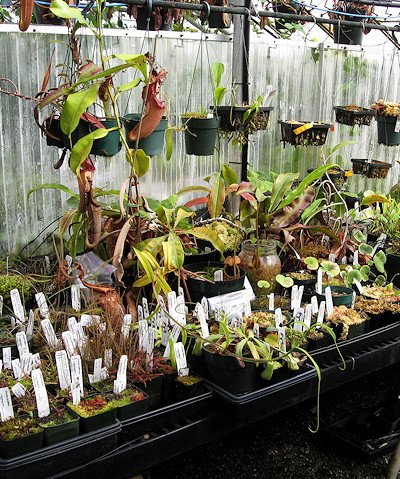
Greenhouses are a great place to grow plants.
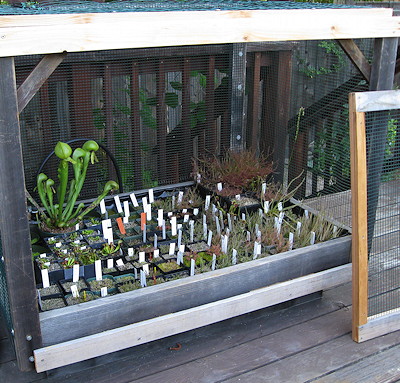
As much as possible you should grow plants adapted to you location outside. The wire mesh is to keep out squirrels, raccoons, and jays.
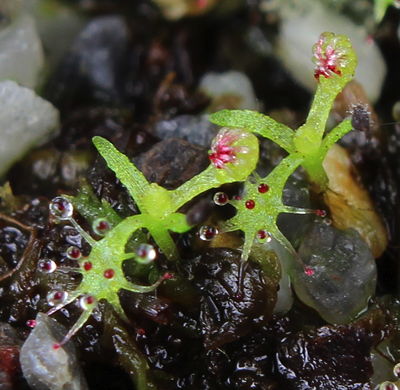
Sprouts of Drosera capensis. Notice the non-carnivorous cotyledon leaves with the seeds still attached.
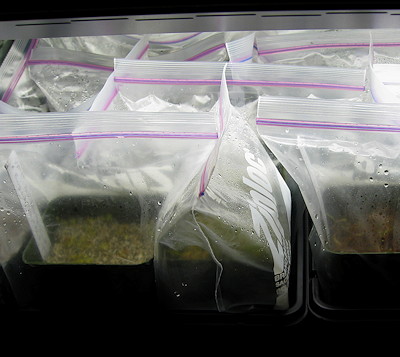
Germinating seeds under a T5, two bulb, fluorescent fixture.
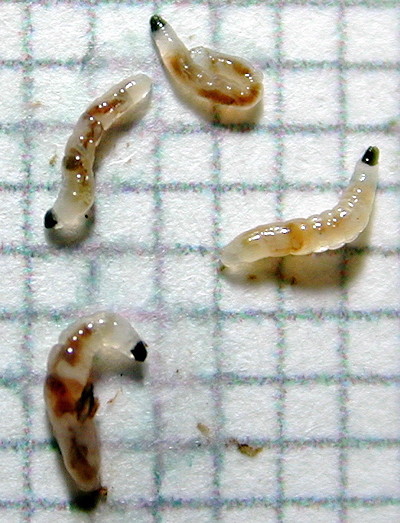
Fungus gnat larvae on a 1 mm grid.
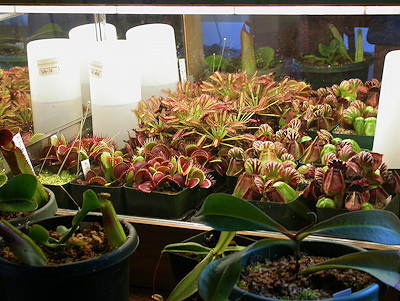
Plants can be grown in a terrarium and under the light spilling out of one. Note the plants are in pots. Planted terrariums are not recommended. Photo by Mach Fukada.
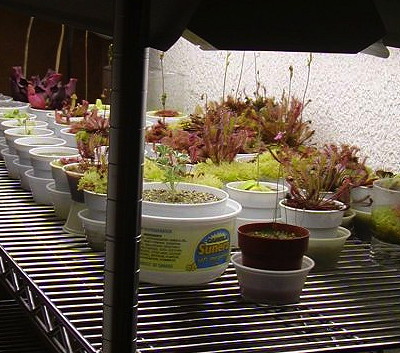
Many species can be grown directly under lights without a terrarium. Photo by ICPS member.
